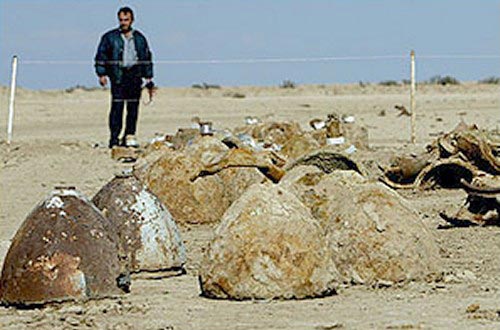| Iraq Destroys More Al
Samoud 2 Missiles
March 3, 2003 01:07 PM EST ...........................................................Saddam Hussein Rejects Going Into Exile
 |
| Iraq Destroys More Al
Samoud 2 Missiles
March 3, 2003 01:07 PM EST ...........................................................Saddam Hussein Rejects Going Into Exile
 |
| Saddam Hussein's scientific adviser, Lt.
Gen. Amer al-Saadi, said Sunday night that Iraq wanted to use DNA testing
to help determine the characteristics of the destroyed anthrax.
The weapons inspectors went Monday to a chemical and explosives plant and a rocket factory where they have been before, and to two import companies and a plastics factory, Iraq's Information Ministry said. The inspectors do not comment on their day's work until evening. Iraq also said inspectors returned to al-Aziziya, an abandoned helicopter airfield 60 miles southeast of Baghdad, where Iraq says it destroyed R-400 bombs filled with biological weapons in 1991. Al-Saadi said 157 of the R-400 bombs contained anthrax, aflotoxin and botulin toxin. He said Iraq has been excavating them and so far has uncovered eight intact bombs, as well as many fragments of destroyed bombs. On Sunday, U.N. weapons inspectors took samples of the material in the bombs to confirm their composition. The destruction of the Al Samoud 2 missiles complies with an order from chief weapons inspector Hans Blix, who said they exceeded the 93-mile range set by the United Nations after the 1991 Gulf War. The casting chambers had been banned and destroyed in the 1990s, but Iraq rebuilt them. Blix's deputy, Demetrius Perricos, said this time they are destroying them in a manner in which they can't be rebuilt. Calling the missile destruction "proactive cooperation from the Iraqi side," al-Saadi said Sunday night that "We hope that it will be to the satisfaction of UNMOVIC," the U.N. inspections program. But al-Saadi said that if the United States indicated it would go to war anyway, Iraq might stop destroying the missiles. "If it turns out at an early stage during this month that America is not going to a legal way, then why should we continue?" he said. The United States, which is leading the push for war against Iraq, had dismissed the missile destruction. The White House called it part of Iraq's "game of deception." Iraq has agreed to destroy all unassembled pieces, software, launchers, fuel and equipment used to make the Al Samoud 2 in "a few days or a very short few weeks," according to Perricos. Al-Saadi indicated was not an easy thing for Iraq to do. He said Iraq won't let anyone see photographs or video images of the missile destruction - despite the potential impact on world opinion - because it would be too bitter for the Iraqi people to watch. "It is too harsh. It is unacceptable," he said somberly. "That's why we have released no pictures." Instead, Iraqis saw Saddam on Sunday night's television news, listening to army officers telling him of their readiness for war. One officer told Saddam that American planes were dropping leaflets. The U.S. military said it dropped 240,000 leaflets in northern Iraq and 360,000 in southern Iraq on Saturday alone. "They weren't able to defeat us with bombs. Are they going to defeat us with leaflets?" Saddam asked the officer. Al-Saadi said U.S. claims that Iraq isn't disarming are lies - and said the only way to find out is with an independent arbiter. "We need a judge on this issue," he said. "The judge is UNMOVIC." Al-Saadi also appealed to Americans' pocketbooks. "UNMOVIC costs $80 million a year. A war would cost upwards of $80 billion - plus bloodshed on both sides," he said. He pointed out that UNMOVIC is financed by Iraq's oil-for-food program and asked which of two possibilities made more sense: "Disarmament - peaceful - at no cost to the American taxpayer. A war - $80 billion - to achieve disarmament." Meanwhile, U.S.-British coalition jets
attacked Iraqi communication sites near An Numinayah and a radar site near
An Nasiriyah, both in southeastern Iraq, the U.S. military's Central Command
reported on its Web site. The targets are in the southern "no fly" zone
set up after the Gulf War to protect Shiite Muslims from Saddam's forces.
|